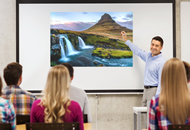|

Teachers have long used pictures in language
classes to motivate students, provide cultural context, and stimulate speaking
or writing (Wright, 1989). They are even more valuable nowadays because of the
importance of visual literacy in the 21st century (Donaghy & Xerri,
2017). This article describes three picture-based activities—talk about,
conversations, and describe-and-draw—with an emphasis on how to use them in a
multilevel class.
1. Talk About
In Talk About, you are at the front of the class,
calling on students to say something about a picture everyone is looking at. In
three stages, you guide the students to talk about the picture. Lower level
students first use single words, then intermediate students engage in guided
descriptions, and, finally, advanced students give explanations and predictions
using more sophisticated language and critical thinking.
In the
Classroom
Using the picture in Figure 1, for example, when
you call on lower level students to share what they see using one word, they
might say:
- “dog,”
- “cow,”
- or “trash.”

Figure 1. Example image for Talk About activity. Source: https://www.flickr.com/photos/lamoney/97461242
The next stage is for intermediate students: Give
them some guidance as you ask them to describe the picture (e.g., “What do you
see? Use in, on, or next to.”)
Students might say:
- “The dog is on the cow.”
- “The cow is in the street.”
- “There is trash next to the cow.”
This step offers a great opportunity to target
recent grammar or vocabulary teaching points. For example, you could ask
students to use present continuous, and they might respond with the
following:
- “The dog is lying on the cow.”
- “The cow is sleeping.”
Finally, call on advanced students. At this level,
students can use more complex grammar and vocabulary. They may also have the
language to express critical thinking. This is a good time to ask deeper
questions to elicit thoughtful responses:
-
“Why is this happening?” → “The dog is unhappy
about the garbage on the street. He doesn’t want to touch it so he’s lying on
top of the cow.”
-
“What will happen next?” → “The cow will ask the
dog to get her something to eat.”
-
“Is this a picture of something bad or something
good?” → “I think having trash and animals on the street makes it unpleasant
for people.” Or “I love this picture of two animals living in
harmony.”
As the three stages have progressed, everyone has
contributed to the class within their capacity: The students are all valued
participants, there’s been an opportunity to review recent vocabulary or
grammar, and the advanced learners have been pushed in their critical thinking
and language output.
Classroom
Management
-
To encourage open responses, it’s helpful to
smile at students for their efforts and for participating in the class.
-
To manage too much
responsiveness, a key point is not to allow students to blurt out answers, but
to give students at lower levels the chance to participate first. This works if
you use your knowledge of students to call on individuals by name.
2. Picture-Based Conversations
Students work in pairs for this activity to create
an imagined dialogue between or among people in a photo. The pictures you need
for this activity should feature two or three people talking together and
interesting backgrounds or situations that can elicit spirited or enthusiastic
discussions. Consider using the NY Times collections,
“40
Intriguing Photos to Make Students Think” and “40
More Intriguing Photos to Make Students Think,” where they have
collected some of their most commented-on images into two slideshows.
In the
Classroom
Choose an interesting image and show it at the
front of the class or on the projector. Pair students up, preferably with
classmates who have similar English proficiency, and ask them to create a
dialogue between two (or more) of the people in the photo. In the example image
in Figure 2, ask your students to imagine a conversation between the child and
the adult.

Figure 2. Example image for Picture-Based
Conversations activity.
Here are some of the conversations that pairs might
come up with, from lower to higher levels.
A: I’m tired.
B: OK. Let’s rest here.
A: [after a few minutes] I’m still tired.
B: One more minute.
A: Where’s the bus?
B: I don’t know. It’s very late.
A: We’ve been waiting a long time.
B: Yes, it’s been more than 20 minutes.
B: We should keep going.
A: I don’t want to go to school.
B: You have to go.
A: Please, not today.
B: Why not?
A: I hate school…someone has been bullying
me.
B: You should tell your teacher.
Classroom
Management
-
For a multilevel class, it helps to put students
in pairs that are equally matched in terms of language ability. That way, a
classmate with higher language proficiency isn’t able to do all the work within
the pair.
-
As you walk around the room observing how
students are doing, urge those who have greater proficiency to write more,
asking questions like, “What else do these guys say to each other?” or “How
does he respond to that?”
-
If the students with beginning proficiency are
not participating, scaffold by giving them an opening line, such as the man on
the motorcycle saying, “Hey, what’s happening?” or “Are you okay?”
Extending the
Activity
If there’s time, you might want to have students
work on their conversations in several more rounds in order to improve both
accuracy and fluency in writing and speaking. Here are some additional steps
for students to create a polished final draft:
-
Write a draft of a conversation.
-
Get feedback from a classmate or the
teacher.
-
Practice the conversation with your
partner.
-
Perform the conversation for classmates sitting
nearby.
-
Perform the conversation in front of the whole
class.
-
Get more feedback from the class or the
teacher.
-
Rewrite the conversation.
-
Record the conversation for
“publication.”
3. Describe and Draw
Sometimes, it’s not logistically feasible to pair
students with classmates at the same level, and sometimes we want an activity
to mix everyone up and build community across proficiency lines. In this pair
activity, one student describes an image while the other draws what they hear
and asks questions for clarification if needed. This activity is good for pairs
in which one student may have a higher speaking proficiency than their
partner.
In the
Classroom
Choose an image for students to describe. If you
are going to project a single picture for the class, have pairs sit tango style
(back-to-back) so that one person can look at the screen and the other can’t
see it. If you have enough pictures for every pair to have a different one,
they can sit across from each other, but those holding pictures should not show
them to their partners. See Figure 3 for a picture I’ve used for this
activity.

Figure 3. Photo of Kirkjufell Mountain in Iceland
for Describe and Draw activity.
If one student has better speaking skills, let that
student describe the picture while the other student draws what is described.
If you’re distributing pictures, you can be very deliberate about this. One way
is to ask students to pair up and then walk around handing out pictures to the
more proficient student in each pair. If you’re going to project a picture, you
can do a roll call for higher proficiency students, inviting them to stand up
and face the front. Then ask the other half of the class to find a partner from
among those standing. Or, keeping it simple, with students in their regular
places, you might just ask, “Who feels like talking more today? You face the
screen.”
Here’s an example of a student conversation
describing the picture in Figure 3:
A: In this picture there is a mountain, a
waterfall, and river with some rocks. First draw the mountain. It’s shaped like
a triangle.
B: Shape what?
A: Triangle. Samgaghyeong.
Triangle.
B: Okay. How big is the mountain?
A: It’s kind of in the middle of the picture, but
maybe a little more to the right, and it takes up almost the whole right half
of the picture.
B: Okay.
A: Now draw a river in front. It curves around the
mountain.
B: Curve?
A: Not straight. Curve. Gogseon. Curve.
You can see from the example that some home
language might be required—if your students share a home language. However, I
try to encourage the describing students to see themselves as teachers. The
goal isn’t simply to finish the activity, but to have everyone learn
something.
If you are responsible for teaching content in
addition to the English language, think about using this activity with pictures
and diagrams related to that content. This way, students can use academic or
job-related vocabulary.
Classroom
Management
As you walk around the class, monitor to ensure
that neither partner in the pair is sneaking looks. The point is to describe
and draw just based on words.
Conclusion
You can easily find lots of interesting
royalty-free images online. Search for “royalty free photos” or, if you have
access to Google, start with a Google images search and then, under Tools,
click on Usage Rights and then Creative Commons Licenses (see Figure 4).
Creative Commons licenses enable free usage and sharing of a work.

Figure 4. Screenshot of Google Images search for
Creative Commons–licensed photos. (Click here to enlarge)
This search will yield photos from sites like
Wikimedia, Flickr, Pixnio, and Pixabay. You might especially be interested in a
collection on Flickr by language teachers.
Talk about, conversations, and describe-and-draw
are activities that you might have tried before. I hope the sample pictures and
the suggestions for doing them in multilevel classes have inspired you to try
them again in a fresh way. The visual element will enliven speaking and writing
classes, and the ways of organizing multilevel classes—beginners first, same-level
pairs, and mixed-level pairs—will ensure everyone gets to
participate.
References
Donaghy, K., & Xerri, D. (Eds.) 2017. The image in English language
teaching. ELT Council.
Wright, A. 1989. Pictures for language
learning. Cambridge University Press.
Note: This article is based on the
presentation “Picture-Based
Activities for Multilevel Classes,” prepared for
the virtual TESOL International Convention, March 2022.
Kitty Barnhouse Purgason is professor emerita of TESOL at Biola University. She has a PhD in applied linguistics from UCLA. She has lived, studied, served, or taught in India, Russia, Korea, China, Turkey, Turkmenistan, Mauritania, Indonesia, Kuwait, Oman, Vietnam, Spain, and Tajikistan. She is a three-time Fulbright fellow and a U.S. State Department English Language Specialist.
|